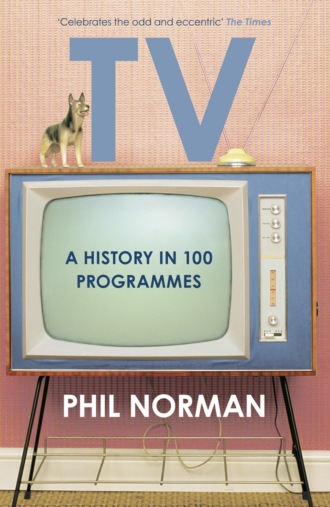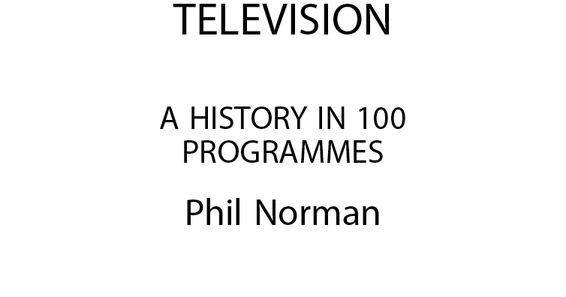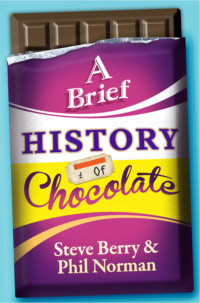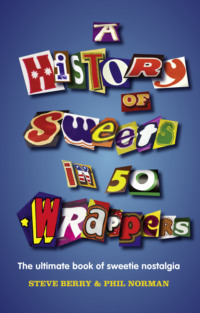
Полная версия
A History of Television in 100 Programmes



Copyright
William Collins
An imprint of HarperCollinsPublishers
1 London Bridge Street
London SE1 9GF
www.WilliamCollinsBooks.com
First published in Great Britain by The Friday Project in 2015
This ebook edition published by William Collins in 2016
Copyright © Phil Norman 2015
Cover photograph © Getty Images/Steven Taylor
Design © Kate Gaughran
Phil Norman asserts the moral right to be identified as the author of this work.
A catalogue record for this book is available from the British Library.
All rights reserved under International and Pan-American Copyright Conventions. By payment of the required fees, you have been granted the non-exclusive, non-transferable right to access and read the text of this e-book on screen. No part of this text may be reproduced, transmitted, downloaded, decompiled, reverse engineered, or stored in or introduced into any information storage retrieval system, in any form or by any means, whether electronic or mechanical, now known or hereinafter invented, without the express written permission of HarperCollins.
Source ISBN: 978-0-00-811332-2
Ebook Edition © September 2015 ISBN: 978-0-00-759140-4
Version: 2016-10-07
Table of Contents
Cover
Title Page
Copyright
Introduction
Tele-Crime (1938–9)
Cookery (1946–51)
Cavalcade of Stars (1949–52)
Crusader Rabbit (1950–1)
The Burns and Allen Show (1950–8)
The Ernie Kovacs Show (1952–61)
The Philco-Goodyear Television Playhouse: Marty (1953)
Small Time (1955–66)
The Phil Silvers Show (1955–9)
A Show Called Fred (1956)
My Wildest Dream (1956–7)
Opportunity Knocks (1956–78)
The Singing Ringing Tree (1957)
Six-Five Special (1957–8)
The Strange World of Gurney Slade (1960)
Armchair Theatre: A Night Out (1960)
Hancock: The Bedsitter (1961)
Kingsley Amis Goes Pop (1962)
That Was the Week That Was (1962–3)
The Sunday-Night Play: A Suitable Case for Treatment (1962)
The Tonight Show Starring Johnny Carson (1962–92)
World in Action (1963–98)
Play School (1964–88)
Crossroads (1964–88)
Le Manège Enchanté (1964–1971) The Magic Roundabout (1965–1977)
World of Sport (1965–85)
Talking to a Stranger (1966)
The Smothers Brothers Comedy Hour (1967–9)
The Prisoner: Fall Out (1968)
If There Weren’t Any Blacks, You’d Have to Invent Them (1968, 1973)
Sesame Street (1969–)
The Owl Service (1969)
Nationwide (1969–83)
The Mary Tyler Moore Show (1970–7)
Miss World (1970)
Columbo (1971–8/1989–2003)
The Largest Theatre in the World: The Rainbirds (1971)
Duel (1971)
The Special London Bridge Special (1972)
Un, Dos, Tres … (1972–2004)
Inigo Pipkin/Pipkins (1973–81)
The Indoor League (1973–8)
Whatever Happened to the Likely Lads? (1973–4)
Thriller (1973–6)
Tiswas (1974–82)
Don’t Ask Me (1974–8)
Supersonic (1975–7)
The Thrilla in Manila (1974)
The Norman Gunston Show (1975–9)
Play for Today: Double Dare (1976)
Pauline’s Quirkes (1976)
I, Claudius (1976)
The Fall and Rise of Reginald Perrin (1976–9)
BBC Nine O’clock News (1976)
Battle of the Network Stars (1976–88)Star Games (1978–80)
Rock Follies (1976–7)
Trans America Ultra Quiz (1977–92)Ultra Quiz (1983–5)
Soap (1977–81)
Roots: The Saga of an American Family (1977)
Leapfrog (1978–9)
The BBC Television Shakespeare (1978–85)
Connections (1978)
Blankety Blank (1979-90)
Life on Earth (1979)
Minder (1979–94)
Now Get Out of That (1981–5)
Artemis 81 (1981)
Hill Street Blues (1981–7)
The Oxford Road Show (1981–5)
Jane (1982–4)
Boys from the Blackstuff (1982)
St Elsewhere (1982–8)
The Tube (1982–7)
M*A*S*H: ‘Goodbye, Farewell and Amen’ (1983)
Saturday Night Affairs (1984)
Threads (1984)
Ever Decreasing Circles (1984–9)
Heimat: Eine Deutsche Chronik (1984)
Moonlighting (1985–9)
Pob’s Programme (1985–7)
The Max Headroom Show (1985–7)
A Very Peculiar Practice (1986–8)
The Comic Strip Presents … Private Enterprise (1986)
Night Network (1987–9)
Mahabharat (1988–90)
Def II (1988–94)
Twin Peaks (1990–1)
Abroad in Britain (1990)
The Real World (1992–)
Come on Down and Out (1993)
Frasier (1993–2004)
Our Friends in the North (1996)
This Morning with Richard Not Judy (1998–9)
The Sopranos (1999–2007)
People Like Us (1999–2001)
Battlestar Galactica (2004–9)
Forbrydelsen (2007–12)
Apple Action News (2009–)
Louie (2010–)
House of Cards (2013–)
Endnotes
About the Author
Also by Phil Norman
About the Publisher
INTRODUCTION
There is no holding down the modern inventor. He rides the waves of the ether with the conquering skill of a master in a celestial rodeo. Give him a valve and there is no holding him. It is almost certain that within a few years we shall have all our entertainment available within our own four walls. Press but the button and a stereoscopic talking film will happen over the mantelpiece.
‘Seen and Heard’, Manchester Guardian, 1 April 1930
IT HAD AN AURA about it, a presence. By today’s standards it was tiny, but it dominated the room in a way its technically superior descendants never quite manage. It catered directly for two of the senses, but in operation it affected them all. The flicker and the glare of the bulbous, grey-green screen. The hum and whine of the tube heating up. The crackle of static when it turned off, the tang of burnt dust in the air when it was repaired. For decades the television set was the most advanced piece of technology to be found in any house. How it worked was a mystery, but it was literally part of the furniture.
It was also an instant portal to a cavalcade of smart, witty house guests with inexhaustible supplies of information, anecdotes, opinions and vibrant sweaters. Miraculous and commonplace at the same time, television occupied a unique position in the national imagination. Detractors claimed it hijacked the national imagination – formerly a cultural Arcadia of chamber music and well-made plays – for its own base ends, but at its best it brought classes and cultures into each other’s homes without prejudice. By the late 1960s even the press admitted that TV, coming from nowhere, was beating them at their own game and several new ones of its own invention.
The birth of television in the mid-1920s garnered more fuss than a royal baby. The race to perfect a workable system was matched by the rush to predict imminent social catastrophe. Newspapers, radio, theatre and even the motor car (why drive somewhere you can see at the flick of a switch?) were pronounced doomed many times. Rumour and misconception abounded. Professor A. M. Low worried about the effect on international relations if Americans could use the new device to view their British neighbours engaged in ‘frightful’ activities, such as drinking cocktails.1 Meanwhile, R. H. Hill of Oxford University demanded, ‘How could one have a bath in comfort if all the neighbours could look in?’2 Noted physicist Sir Oliver Lodge fretted that broadcasting’s electromagnetic waves might make planes fall out of the sky, though he didn’t expect TV to become a working reality ‘for a good many years yet, perhaps not for a century’.3
More usefully, Lodge worried about content, noting that the majority of messages sent by another recent scientific triumph – the transatlantic telegraph cable – were ‘rubbishy’. ‘It is no use enlarging our powers of communication,’ he warned, ‘if we have nothing worthwhile to say.’4 The insubstantial nature of the early demonstrations didn’t help – even John Logie Baird provoked a wave of cheap laughs when he based his first telerecording demo around a cabbage.
Initially the preserve of the rich, the take up of TV spread after the Second World War as prices dropped and services improved. Older media, who had originally described it as an elitist fad for well-to-do stay-at-homes, now tried to dismiss it as a pernicious influence on those less stable, less educated than themselves. A snobbish line in the fifties had it that people were raising H-shaped aerials over their houses to make up for all the ‘H’s dropped inside them.
It may have projected a serene, slightly aloof air on screen, but behind the cameras post-war television was paddling like mad, inventing a new medium on the hoof, often with whatever came to hand. Studios looked less like the glistening caverns of today and more like the shop floor of an engineering works under the stewardship of a hyperactive ten-year-old. A profession was being steadily built through years of committed bodging.
America initially lagged behind Britain, Germany, France, Italy, Russia and Japan in television take up, but soon made up for lost time. NBC’s first electronic transmission in 1936, featuring comedian Ed Wynn, ignited an industrial boom that in little over a decade would result in four national television networks broadcasting to over four million set-equipped homes. The US network system, commercially funded and powered by the twin big tickets of sports and vaudeville, was voracious and unstoppable. By the late 1940s its diverse schedule offered programmes that were sombre (Court of Current Issues, People’s Platform), sophisticated (Café de Paris, Champaign and Orchids) and silly (Buzzy Wuzzy, Campus Hoopla).
This last category caused unease back in Britain, where ITV’s arrival in the mid-1950s threatened the state-run BBC order. The US broadcasts of Elizabeth II’s coronation had included grinning appearances by NBC’s mascot, chimpanzee J. Fred Muggs, and there were concerns about a similar crassness creeping in to British broadcasting. The Tories championed ITV, Labour vilified it, while Liberal councillor Paul Rose reminded both sides that ‘there is always freedom of the knob.’5
Technological advance was an enduring obsession, if not always taking place as quickly as predicted: a committee set up in 1943 to prepare for British television’s post-war return anticipated the swift invention not only of colour, but 1000-line high definition and 3D.6 A quarter of a century later, round the clock coverage of the Apollo missions fused the Television Age with the Space Age for as long as the latter held out, and made a star of James Burke, who went on to present the most lavish science programmes ever made, travelling further on a BBC expense account than Armstrong ever managed in a Saturn V. On a smaller scale, potting shed innovation was everywhere, from the BBC’s home computer sideline to abortive plans in the late 1960s for contestants on The Golden Shot to operate the game show’s famous crossbow from their own front rooms, via a Golden Joystick in a James Bond-style Golden Suitcase, specially delivered in a Golden Car. The technology, the producers made clear, boasted Golden safety features as ‘we don’t want any nut shooting Bob Monkhouse.’7
Around this time came the first symptoms of two ailments that would dog the medium for evermore. The first was the transformation of the social embarrassment surrounding television among the middle classes into an ironic ‘guilty pleasure’. As John Osborne confessed to Kenneth Tynan in 1968, ‘When TV is dreadful, it’s thoroughly enjoyable. After you’ve seen The Golden Shot a couple of times, it acquires a special horror of its own.’8 The second, closely related to the first, was nostalgia. In the dying days of 1969, ITV screened A Child of the Sixties, taking the temperature of the decade with a rummage in the archive. This sort of thing was nothing new in itself, but for the first time whimsical talking heads were added, including ‘the impressions they made on a receptive young mind’ – an Oxford undergraduate named Gyles Brandreth. The bar for retro-punditry was set from that moment.
The study of television doesn’t have to be so apologetic. Television may not be high art, but many artists have worked in it, regardless of its condemnation as unclean by the world’s cultural custodians. Samuel Beckett wrote for it. Kingsley Amis presented a pop music show on it. Carol Ann Duffy laboured in it writing cockney gags for Joe Brown’s snakes and ladders game show Square One on her way to becoming Poet Laureate.
As a vivid source of graphic reportage, television transformed our relationship with the world at large. When the Vietnam War stopped being a few fuzzy black and white images accompanied by sober paragraphs of text and became an avalanche of explicit, full-colour moving horrors, western populations seriously reconsidered the wisdom of military adventures. Dramatists, meanwhile, found a unique new medium that was more intimate than cinema, more precise than the theatre and which could pluck the hearts of millions. Worries about the creation of a world of antisocial couch ornaments were outweighed by a sense of barriers and borders vaulted by satellite, a shift in the way we looked at the world that wouldn’t happen again until the advent of the Internet.
If that arrival meant the writing was on the wall for television’s place in the media vanguard, for most it was hard to read. Prestel, the British Post Office’s pioneering online data service, was struggling by 1982. Punters predicted that staring at a load of text was so passé in the age of the image it would never catch on. ‘Prestel and The Two Ronnies … have no more in common than the Financial Times and Hammond Innes,’ reasoned Hamish McRae. ‘It would further follow that it is pointless to give people who want to watch The Two Ronnies a Prestel set that tells them the time of the trains to Newcastle.’9 Such faultless logic buoyed TV’s unassailable self-image until it was far too late, at which point panic set in.
Factual programmes in particular are acutely conscious of the Internet looking over their shoulders. Current affairs channels pride themselves as vital parts of the democratic machine, but TV could never make on-screen democracy work. In May 1982, World in Action tried to atone for the scarcity of news coming out of the Falklands Conflict with a high-tech viewer vote. This consisted of 75 homes being equipped to give instant reaction to the big questions of warfare. The set-up worked fine, but a naively honest on-screen tally of the total votes showed less than half the audience, specially wired in at great fuss, were actually bothering. Viewer participation remains largely a token gesture – and, thanks to premium rate phone lines, often the token that pays for the programme.
Before the Internet took its place as the number one scourge of decent society, television’s constant stream bred disdain. A novel takes its place in the literary canon. A film lines up in the cinematic pantheon. Television programmes just float there, then vanish. While films relate to other films at a distance, via elegant homage or the critic’s comparative whim, a TV show arrives surrounded by other shows before and after, on other channels, from other seasons. It’s an adaptation of this Danish show, a reboot of that long-forgotten space opera, or a strange amalgam of those two 1970s programmes presented by that newsreader who’s suddenly all over the place after she showed how game she was, doing that soap opera parody on a charity special. Never mind placing a programme in context, it’s an afternoon’s work just to pull the thing out of the undergrowth.
Small wonder that early critics, fearful of getting their hands dirty with this suspicious new medium, contented themselves with a few tentative pokes and prods at TV as a whole – muttering darkly about ‘admass’ and ‘diachronic flow’, and treating it with the loftiness of the anthropologist. For these early critics, TV could best be understood as the by-product of some industrial process or quaintly exotic lower culture: it was an experimental new plastic from the labs of ICI, or the campfire story of a backward tribe. Aside from the odd accidentally interesting curio, artistic judgement was hardly appropriate. The Guardian’s TV editor Peter Fiddick noted that TV’s lowly status could lead, at worst, to ‘know-nothings writing for care-nothings about stuff that [is] worth nothing.’10 That was in 1982. Things have got worse since.
So here’s an attempt to revisit and revive the history of the idiot’s lantern. A hundred programmes have been gathered to chart eighty-odd years of televisual evolution. It is, admittedly, a predominantly Anglophone, western collection. Though the Global Village has lately begun to live up to its name, TV around the world has overwhelmingly followed blueprints drawn up by British and American hands.
A crudely calibrated Hundred Greatest, a solemn Hall of Fame, would give only a fraction of the picture. This book aims to celebrate and mimic the serendipitous joy of that scheduling jumble which, in the days of restricted channel numbers, threw up dizzy juxtapositions daily: an earnest play might be followed by a big broad variety spectacular; a horror anthology that drove children behind furniture followed a sketch show that chewed the carpet. This riotous mix, now slowly disappearing as themed channels and on-demand services take over, may have downgraded TV’s importance in the eyes of aesthetes, but gave it a community feel other media lacked. No-one ever turned up at a cinema half an hour early for a screening of Three Colours: Red and got thirty minutes of Slam Dunk Ernest for their trouble.
This isn’t a book about how much ‘better’ television once was, but how much stranger it used to be – much braver, more foolhardy, unselfconscious and creatively energetic before commerce knocked those fascinating corners off its character. At its best and at its worst, television is brutally honest and charmingly deceitful, sentimentally partisan and coldly dispassionate, obscenely lavish and ludicrously cheap. Its screen bulges with obsessive perfectionists and clueless amateurs, sociopathic monsters and all-round good eggs. It can’t be contained by a neat little narrative. It’s chaos all the way down.
No countdown of the top hundred shows can do television full justice. But maybe a more varied hundred can make a better stab at exploring it: a rough guide antidote to the standard lists of well-worn greats. What follows is one such alternative trek. Overlooked gems and justly wiped follies, overcooked spectaculars and underfunded experiments are as much a part of TV history as the national treasures and stone cold classics. They can tell us just as much, and sometimes more, about the nature of television, those who crafted it and those who lapped it up. Here, then, are tales of the days when television was at the most exciting, creative stage of any medium: a cottage industry with the world at its feet.
TELE-CRIME (1938–9)
BBC
The original TV drama series.
When the BBC asks a question, it isn’t just a question, it’s a ‘viewer participation programme’.
Grace Wyndham Goldie, Listener, 2 March 1939
IN BBC TELEVISION’S BRIEF life before the war, drama meant the theatre: simple studio productions of acknowledged classics or extracts from a show currently running in the West End. These unofficial trailers were either recreated in the studio (with as much of the theatre’s scenery as could be blagged) or occasionally and chaotically broadcast live from their home turf. Champions of theatre broadcasts claimed the presence of an audience added atmosphere and upped the actors’ game – the fact that the cameras often ended up chasing them about the stage, like a football match filmed by a bunch of drunken fans, was a small price to pay.
Visuals took a back seat at first. Early TV equipment produced low-definition pictures in murky black and grimy white. Faces had to be held in tight close-up to enable recognition, and wide shots couldn’t be that wide due to the Beeb’s tiny Lime Grove studios. Sets and lighting just about did the job, and nothing more. Directors couldn’t cut between cameras – a change of shot had to be done by mixing, which could take several seconds. With all these restrictions, wrote the critic Philip Hope-Wallace, ‘the television screen is much less a stage … than a checking-board helping us listen to good talk.’11






